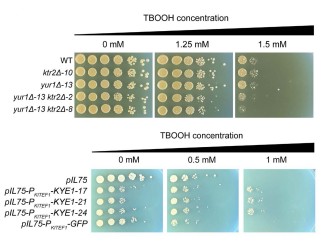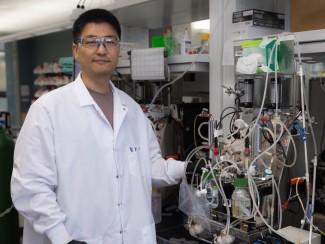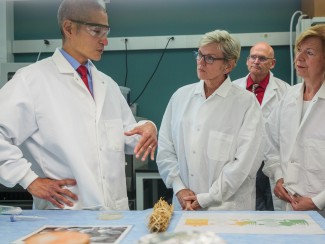
Daniel Amador-Noguez is learning how living organisms transform nutrients into energy and other useful chemicals. Among a cadre of scientists looking at the biological underpinnings of metabolism, Amador-Noguez knows firsthand the links between the fuel that makes our bodies go and the biofuels that propel our machines. Because he studies both.
When it comes to metabolism, though, there are a lot of unanswered questions. Why are some organisms capable of rapidly breaking down nutrients while others take longer? Why can some creatures consume just about anything, and others have to eat baked chicken every night or their GI tract revolts? And how do we draw maps of the way all this stuff works?
Getting to the bottom of these mysteries could help Amador-Noguez, an assistant professor of bacteriology, improve biofuels, inform us about our guts’ determinations of what’s friend or foe, and even provide the basic science to individualize medical treatments based on a person’s own microbiome.
Amador-Noguez focuses on the series of chemical reactions that occur when tiny living things digest, otherwise known as microbial metabolic networks. He’s trying to figure out how to make microbes metabolize differently than the way they’re programmed.
Specifically, as a researcher with the Department of Energy (DOE)-funded Great Lakes Bioenergy Research Center (GLBRC), Amador-Noguez is tasked with convincing a broad swath of microbes to metabolize often difficult-to-swallow parts of plants in a way that transforms them into fuels and high-value bioproducts. We spoke to him about the passion behind his vocation and how studying biofuels and the gut microbiome might not be all that different.
Why study metabolism in bacteria?
It’s a lot faster than studying metabolism in mice, which is what I used to work with. You can do genetic manipulations much faster, so you can really get at the molecular mechanisms of how metabolism and different parts of the cell are working. Bacteria are a really good system for rapidly testing specific hypotheses and finding answers fast.
Bacteria play such a huge role in human metabolism, too. Not only do they transform the things that we eat into something else, bacteria can also chemically alter the molecules that we make ourselves. This can have a big effect on human physiology because these microbes can potentially modify the hormones or signaling molecules within our bodies that give our cells instructions on how to operate.
The GLBRC has many different goals about improving biofuel and bioproduct production. How does being part of this mission benefit your work as a CALS professor?
GLBRC has been great for many reasons. We are all working toward a common goal — generating the basic knowledge that we need to be able to efficiently convert plant biomass into biofuels or other high-value chemicals. That’s a cohesive goal.
Being part of GLBRC accelerates my research and the amount of progress that I can make because, if I’m trying to solve a particular problem, I don’t have to be an expert in every single aspect of it.
For example, in my lab, we are experts at understanding and investigating regulation of bacterial metabolism using mass spectrometry. We are not plant biologists or enzymologists, but other people on campus and in GLBRC are. And because we don’t have to learn how to do that, the research goes a lot faster.
That’s part of the reason why the DOE is funding these bioenergy research centers. They realize there’s a lot of synergy that takes place when you have a large group of investigators working together toward a common goal.

With such a basic process like metabolism, how do you know what to study?
We are trying to generate a holistic understanding of how bacterial metabolism is regulated. What that means is that we are not trying to understand just how a single enzyme is regulated. We are trying to understand how complete pathways and metabolic networks work.
In the case of GLBRC, we care about the products, which to the microbe are waste but to us are the biofuels that we are trying to produce.
We have also been developing new tools to increase the number of metabolites — molecules that serve various functions in the process — that we can measure within the cell while broadening our understanding of why metabolism happens at certain rates in the cell.
We apply state-of-the art tools to study microbes that have not been examined before. We know a lot about model organisms, such as E. coli, but the microbes that are actually going to be useful for biofuel production could be some other lesser-known microbes that have much better properties for this purpose.
Zymomonas mobilis [a focus of GLBRC research] is a really good example of that. It’s extremely fast at converting glucose into ethanol and is also highly resistant to the environmental stressors that are normally present in biomass-derived sugars. Acquiring a deeper understanding of Zymomonas metabolism will allow us to engineer its metabolism for improved production of biofuels and other high-value chemicals as well as improve our ability to transfer its more desirable properties to other fuel-producing microbes down the road.
So how do you figure out how to make these pathways work faster?
One way we can potentially improve the production capabilities of a biofuel-producing pathway is by improving the thermodynamics of that pathway. Thermodynamic analysis, a powerful tool for pathway design and metabolic engineering, can help us understand how energy is transferred and transformed within these networks.
Within a particular pathway there can be what we call “thermodynamic bottlenecks.” Changes in free energy across the pathway may not be distributed uniformly. There can be big drop after big drop when things are going the way we want them to, but then there may be a very flat part, where things go slow, slow, slow.
Like a water slide?
Yes, exactly. The steeper the slope, the faster it’s going to go. And if the slope is kind of flat, then things are going to move a lot slower. In our laboratory, to measure changes in free energy at each step in a metabolic pathway, we combine mass spectrometry; nonradioactive isotope tracers, which work like different colored paints added to a flowing river, allowing us to determine how fast a particular pathway or reaction is operating; and computational modeling. In other words, these approaches help us measure the slope along the way. That way, we can identify those flat parts and learn how we can modify and make them steeper or, for our purposes, faster.
Speaking of slope, it seems like a lot of this research is being done on a steep learning curve.
All these types of studies used to be incredibly tedious. It was a very slow process, and you had to go step by step, analyze metabolite by metabolite. Through the use of mass spectrometry equipment provided by CALS and GLBRC, we can potentially analyze hundreds of metabolites within the cell at once. With tracers and modeling, we can measure the activity of entire pathways and even metabolic networks.
You also study the human gut microbiome — how microbes help us digest things. What’s the difference between studying what happens when I eat a cheeseburger and your research into biofuels?
Actually, it’s fundamentally the same. When you eat a cheeseburger, you are essentially using the same metabolic pathways that the bacteria is using. The glycolytic pathway, which converts sugar into energy and biosynthetic precursors that we can, in turn, convert into fuels and bioproducts, for example, is essentially identical in E. coli and in human cells. So whatever we can learn about the regulation of this pathway in bacteria can potentially be applied to human systems, too. I’m very curious as to how things work, but I’m also very curious as to how we can make them work for ourselves. Microbes can be used as factories for the production of almost any imaginable compound, whether its biofuels, high-value chemicals, or pharmaceuticals. The goal of my laboratory is to generate the fundamental knowledge required to be able to do this quickly and efficiently. The understanding of bacterial metabolism requires a tinkering type of approach about how different pieces of cellular machinery fit together — that makes me keep asking, “How can we make something useful out of this knowledge?”





